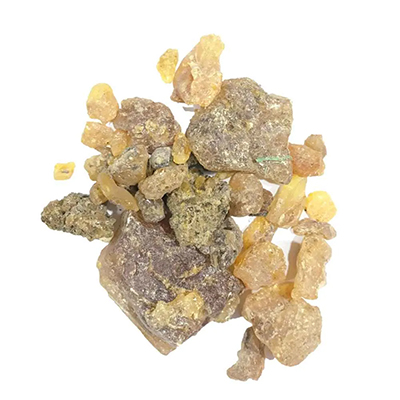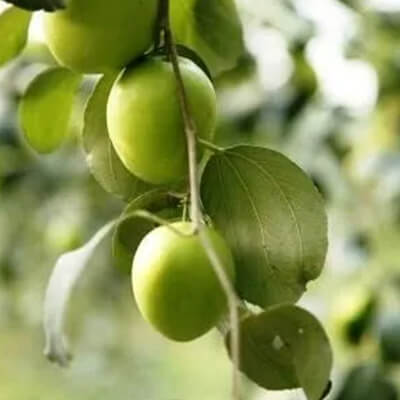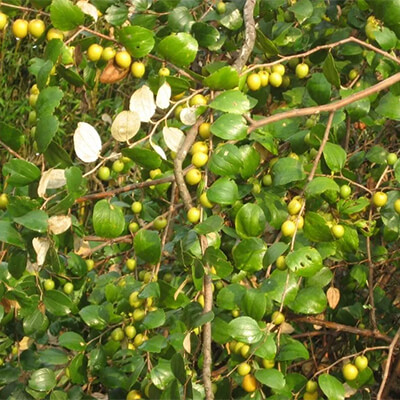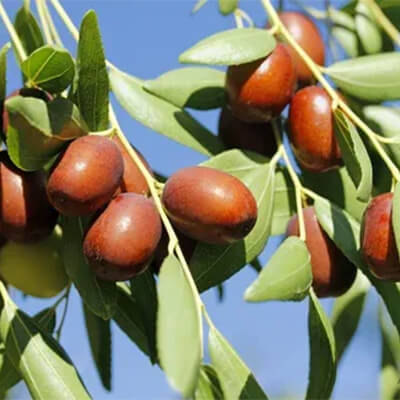On This Page
Sarja (Vateria Indica) – The White Dammar or Indian Copal Tree
Introduction
“Sarja” also famous as “Kahruba” is a multipurpose plant that has medicinal as well as economic importance. Sarja is a large evergreen tree that has been used for making varnishes and as incense from ancient times. Sarja botanically known as Vateria indica has been described by Hook in 1874 and Gamble in 1915. Reference to Sarja is also available in astrological science that makes us understand its bondage with tradition and culture. Sarja is used for the treatment of various respiratory, and reproductive system disorders along with skin disorders, diabetes, piles, etc of its various pharmacological activities like anti-inflammatory, anti-cancerous, wound healing, anti-bacterial, etc. properties. “Sarjrasa” is the oleoresin that is obtained from Vateria indica. Sarja yield semi-solid fat Dhupa fat or Malabar Tallow, piney tallow which is used as an adulterant of Ghee and for edible purpose. It is also used as a substitute for cocoa butter or blends with cocoa butter.
The Important Point to Know about Sarja
- Sarja is believed to be Vateria indica Linn. But it may be noted that many tree species characterized by resinous exudation, especially those belonging to the family of Dipterocarpaceae and Combretaceae are given names such as Maha Sarja, Laghu Sarja, Nadi Sarja, Nila Sarja, Sarjaka. Thus, it may be presumed that Sarja could better be a group name for all such trees showing resinous exudation.
- Although the resin of Shorea (Shaal) is being used as Sarjarasa by Vaidyas Unani Hakims do use the resin of Vateria indica under name of Chandrarasa which is considered equally useful. According to Acharya Yadavji, both varieties of resins being recognized as Sarjarasa by the ancients cannot be over-ruled.
Basonym of Sarja
सर्ज्यते। षर्ज अर्जने।
Sarja (Vateria indica Linn.) grows robustly.
Synonyms of Sarja
- According to Properties and Action
सर्जरसः – सर्जस्य रसः।
The useful part of Sarja is its exudate.
देवधूपः – देवानां धूपः।
The resins of Sarja are used for fumigation.
रालः – राति दधाति सुखं अलक्ष्मीनाशनेन।
The odor of fumigation done with Sarja rasa is pleasing to the mind.
Other Synonyms of Sarja are:
- Ajkarna
- Bastakarna
- Gandhvriksha
- Ranjanadruma
- Chiraparni
- Divyasara
Regional Names of Sarja
- White dammar (English)
- Kaharuba (Hindi)
- Billidhupa, Rala Bilagaggala (Kannada)
- Payin (Malayalam)
- Ral (Marathi)
- Safed Dammar (Tamil)
- Kungiliyam, Vellai Kundarakam, Vellaikuntirikkam (Telugu)
- Misbah-ul-room (Arabic)
- Kahrubashamayi (Persian)
Botanical Name
Vateria indica Linn.
Vateria – In memory of Abraham Vater
indica – Native of India
Family
Dipterocarpaceae (Shala Kula)
Ayurveda Reference for Sarja (Vateria indica Linn.)
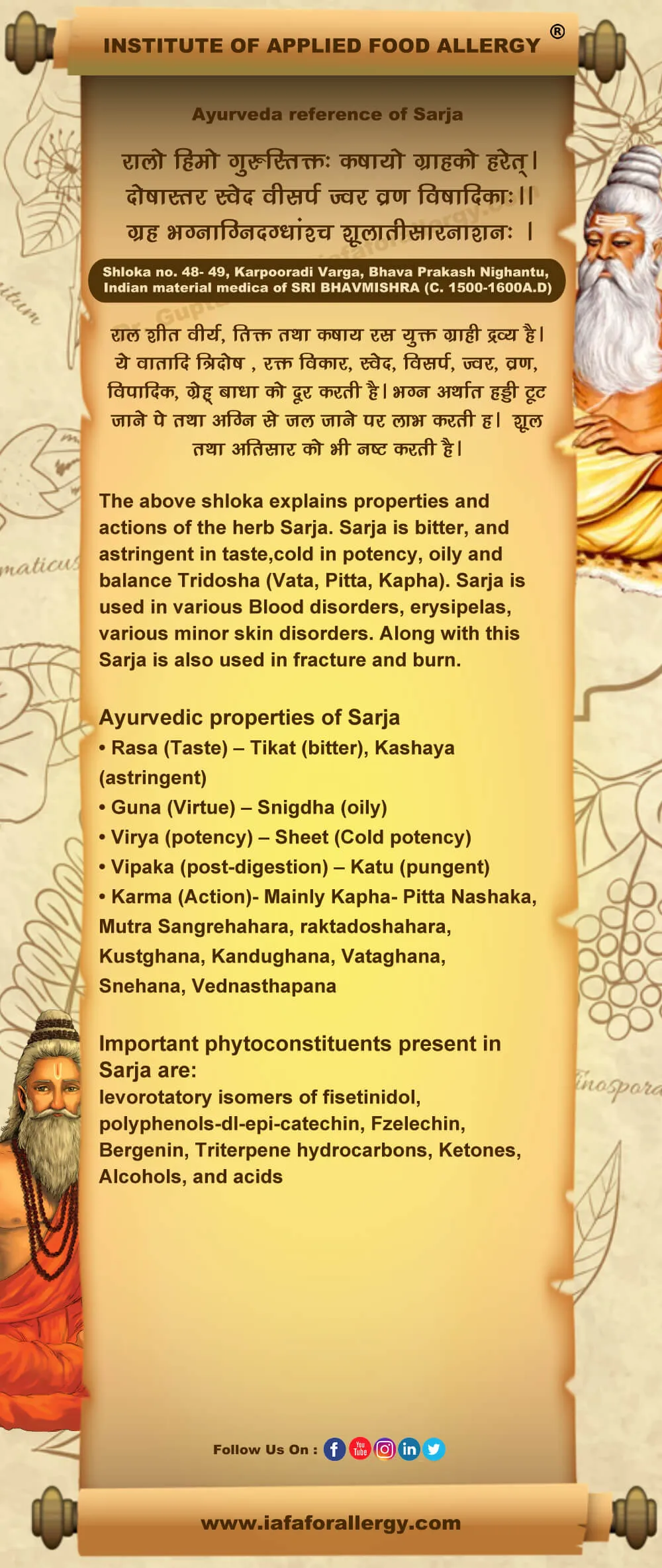
Scientific Classification of Sarja
| Kingdom | Plantae |
| Class | Dicotyledons |
| Subclass | Polypetalae |
| Series | Thalami florae |
| Order | Guttiferales |
| Family | Dipterocarpaceae |
| Genus | Vateria |
| Species | indica |
Classification of Sarja as per Charaka and Sushruta
- Charaka: Kashaya Skandha * not mentioned in Mahakshaya
- Sushruta: Shaalsaaradi Gana
Sarja, Sarjnaam Description in Brihtrayi
| Charaka | Shusruta | Vagbhata (Ashtang Hridya) |
| C. S. Su. 3/ 4 | S. S. Su. 6/ 33 | A. H. Chi. 1/ 163 |
| C. S. Vi. 8/ 151 | S. S. Su. 14/ 37 | A. H. U. 16/ 24 |
| C. S. Chi. 3/ 257 | S. S. Chi. 1/ 95 (Sarjnaam) | A. H. U. 25/ 58 |
| C. S. Chi. 6/ 30 | S. S. Chi. 3/ 6 | A. H. U. 27/ 14 |
| C. S. Chi. 25/ 90 | S. S. Chi. 9/ 14 | A. H. U. 28/ 34 |
| C. S. Chi. 26/ 240 | S. S. Chi. 19/ 31 | |
| C. S. Chi. 29/ 113 | S. S. Chi. 20/ 9, 19 | |
| C. S. Chi. 30/ 121 | S. S. Ka. 6/ 3 | |
| S. S. U. 21/ 43 | ||
| S. S. U. 34/ 5 |
Sarjrasa, Sarjaj Description in Brihtrayi
| Charaka | Shusruta | Vagbhata (Ashtang Hridya) |
| C. S. Su. 3/ 9 | S. S. Su. 5/ 19 | A. H. Su. 21/ 14 |
| C. S. Su. 5/ 19 | S. S. Su. 12/ 27 | A. H. Su. 29/ 25 |
| C. S. Chi. 7/ 120, 127 | S. S. Su. 14/ 37 | A. H. Chi. 4/ 12 |
| C. S. Chi. 14/ 52, 220 | S. S. Su. 16/ 27 | A. H. Chi. 19/ 67, 71, 77 |
| C. S. Chi. 17/ 78, 144 | S. S. Su. 37/ 22, 29 | A. H. Chi. 22/ 21, 22 |
| C. S. Chi. 21/ 76 | S. S. Su. 38/ 24 | A. H. U. 16/ 52 |
| C. S. Chi. 23/ 99 | S. S. Sa. 10/ 57 | A. H. U. 22/ 6 |
| C. S. Chi. 29/ 21, 22 | S. S. Chi. 1/ 85 | A. H. U. 24/ 52 |
| C. S. Si. 7/ 56 | S. S. Chi. 3/ 58 | A. H. U. 27/ 38 |
| C. S. Si. 8/ 35 | S. S. Chi. 5/ 12 | A. H. U. 28/ 35 |
| S. S. Chi. 8/ 44 | A. H. U. 32/ 25 | |
| S. S. Chi. 9/ 10, 58 | A. H. U. 32/ 56 (Sarjaj) | |
| S. S. Chi. 15/ 30 | A. H. U. 35/ 22 | |
| S. S. Chi. 18/ 33 | ||
| S. S. Chi. 22/ 5, 69 | ||
| S. S. Chi. 40/ 4 | ||
| S. S. Ka. 6/ 16 | ||
| S. S. U. 21/ 44 | ||
| S. S. U. 24/ 27 | ||
| S. S. U. 31/ 4 | ||
| S. S. U. 32/ 4 | ||
| S. S. U. 33/ 4 | ||
| S. S. U. 35/ 6 |
External Morphology of Sarja
- Habit: Sarja is a large and handsome tree.
- Bark: Its bark is whitish.
- Branches: Young branches clothed
- Leaves: Simple, 12 to 20 cm long, 5 to 10 cm wide, elliptic-oblong,
- shortly pointed or obtuse, cordate base. 12 to 15 pairs of lateral nerves are present. The petiole is 2.5 cm long.
- Inflorescence: Terminal panicle
- Flowers: Small, 6 mm in diameter, and white.
- Fruits: Capsule 6 cm long and 3.5 cm wide, fleshy, oblong, and 3 valved. Each valve comprises one seed.
Sarja Rasa (oleo gum resin)
Resin is exuded by the tree of Sarja which is known as Dhupa or Piney Resin or white Dammar. It is obtained by tapping the tree by making semicircular incisions on the stem through the cork cambium, up to the surface of the Sapwood. Blazes or cuts are spaced to cause less damage to the tree. The resin starts oozing from the incisions in 3-4 days and is continuous for 60 – 90 days. The resin is also exuded when the bark is scorched by lightning fire around the base of the tree the method gives a high yield of resin but damages the timber and may even kill the trees (Sarjvriksa).
Flowering and fruiting time
Fruits ripen June- July (artificial regeneration plantation) with the commencement of monsoon and start falling to the ground.
Distribution of Sarja
Sarja occurs in Southern – Western India. It is indigenous to the evergreen forest of the Western Ghats from North Kanara to Kerala. It is also planted extensively as an avenue tree in Karnataka and is suitable for afforestation evergreen forests of Eastern Ghats.
The Useful Part of Sarja
The useful part of Sarja is the Niryasa (Exudate)
Important Phytoconstituent of Sarja
The bark of Sarja contains:
- levorotatory isomers of fisetinidol
- polyphenols-dl-epi-catechin
- Fzelechin
- Bergenin
Oleo-the resin of Sarja contains:
- Triterpene hydrocarbons
- Ketones
- Alcohols and acids
Oleoresin of Sarja on distillation gave an essential oil (76%) that consists of azulenes and phenolic constituents
Leaves & Roots of Sarja contains:
- Bergenin
- Phenols
Seeds contain bergenin
Fruits contain tannins (25%)
Recent Research on Sarja
- Anti-inflammatory
- Anti-helminthic
- Anti-tumor
- Anti-ulcer
- Antioxidant
- Anti-mutagenic
Rasa-Panchaka (Properties) of Sarja
| Rasa (Taste) | Tikta (Bitter), Kashaya (Astringent) |
| Guna (Virtue) | Snigdha (Oily) |
| Virya (Potency) | Sheet (Cold Potency) |
| Vipaka (Post-Digestion) | Katu (Pungent) |
| Dosha Karma (Action on Dosha) | Mainly Kapha – Pitta Nashaka, Mutra Sangrehahara, raktadoshahara, Kustghana, Kandughana, Vataghana, Snehana, Vednasthapana |
Prayogarha Vyadhi (Therapeutic Indication) of Sarja
Vidridhi, Badhirya, Vaivarnya, Krimi Roga, Yoni Roga, Kustha, Kandu
Aamyik Prayog (Therapeutic Uses) of Sarja
- Grahani Roga (Sprue) – Sarjarasa mixed with jaggery (Sharkara) should be taken to control Grahani Roga. (Bhavaprakasa Chiktsa Sthan. 4/ 58))
- Vatarakta (Gouty arthritis) – The external application of oil processed with sour gruel and Sarja alleviates fever, burning sensation, and pain. (Charaka Chikitsa Sthana. 29/ 122)
- Abhighata (Wound) – Sarja Rasa should be used for fumigating the wound. (Sushruta Sutra Sthana. 37/ 21)
- Padadari (Cracks on the sole) – Powder of Sarja and rock salt mixed with honey and mustard oil should be churned and applied locally.(Vrinda Madhava 57. 11)
- Kshudra Roga (minor disease – Whitlow) – After fomenting with the hot water the powder of Sarj rasa should be applied to the wound and bandaged. (Vrind Madhava. 57/ 17)
Important Benefits of Sarja
- Sarja Rasa obtained from the bark of the tree is used in throat troubles and chronic bronchitis
- Sarjarasa is used for the treatment of wound healing, ulcer healing, asthma, leprosy, cough, skin eruptions and crack infection.
Matra (Therapeutic Administration and Dosage) of Sarja
- Niryasa (Exudate) – 1- 3 gram
- Kwatha (Decoction) of Sarja – 50 – 100 ml

Have A Health Issue?
Consult Online
- Dr. Sahil Gupta (B.A.M.S., M.H.A.)
Ayurvedic Allergy Specialist
CEO & Founder of IAFA®
Classical Reference of Sarja (Vateria indica)
Kaiyadeva Nighantu Aushadhiadi Varga, 842- 843
अजाकर्णो लतावृक्षो बस्तकर्णोथ सर्जक: |
कुशरीर: स्नेहहर: कषायी रञ्जनद्रुम: ॥
सर्जकषायो वर्ण्यश्च कफस्वेदमदकृमीन् ।
वधर्मर्विद्रधि बाधिर्य योनिकर्णरुजाः हरेत्॥
Raja Nighantu, Prabhadradi Varga, 78- 80
a. सर्जस्तु तुवरस्तिक्त: हिम: स्निग्धो अतिसारजित्।
पित्तास्रदोषकुष्ठष्न: कण्डूविस्फोटवातजित्॥
b. सर्ज: सर्जरस: शाल: कालकूटो रजोद्धवः |
वल्लीवृक्षश्चरपर्णी राल: कार्श्यो अजकर्णकः ||
वस्तकर्ण: कषायी च ललनी गन्धवृक्षकः |
वंशश्च शाल निर्यासो दिव्यसार: सुरेष्टकः ||
शूरो अग्निवल्लभश्चेव यक्षधूप: सुसिद्धकः।
c. सर्जस्तु कटुतिक्तोष्णो हिम: स्निग्धो अतिसारजित् ।
पित्तास्रदोषकुष्ठनुत् कण्डूविस्फोटवातजित् ॥
Kaiyadeva Nighantu Aushadhiadi Varga, 842- 843
Sarjrasa Tailam
तैलं सर्जरसोद्धृतं विस्फोटकविनाशनम् ॥
कुष्ठपामाकृमिहरं हन्यात् श्लेष्मानिलामयान्।
कषायतिक्तकटुकं सारलं व्रणजन्तुजित् ॥
Raja Nighantu, Chandanadi varga, 329 – 330
रालः सर्जरस:
राल: सर्जरसश्रैव शाल: कनकलोद्धवः ।
ललन: शालनिर्यासो देवेष्ट: शीतलस्तथा ॥
बहुरूप: शालरस: सर्जनिर्यासकस्तथा।
काल: कललज: प्रोक्तो नाम्ना सप्तदशांकित: ॥
Raal Guna
रालस्त शशिर: स्निग्ध: कषायस्तिकत संग्रह:।
वातपित्तहर: स्फोट कण्डूतिवर्णनाशनः।।
Bhavaprakasha Karpuradi Varga, 48- 49
रालस्तु शालनिर्यासस्तथा सर्जरस: स्मृतः ।
देव धूपो यक्षधूपस्तथा सर्जरसश्च सः ॥
रालो हिमो गुरुस्तिक्त: कषायो ग्राहको हरेत्।
दोषास्तर स्वेद वीसर्प ज्वर व्रण विषादिका: ॥।
ग्रह भग्नाग्निदग्धांश्च शूलातीसारनाशन: ।
Bhavaprakasha Chikitsa, Grehani Roga Adhikara, 4 / 58
ग्रहणयां सर्ज रस चूर्णम
श्रेतो वा यदि वा रक्ताः सुपक्वो ग्रहणीगदः ।
गुडे नाधिकसर्जेन भक्षितेनाशु नश्यति ॥
Chakradutta, Kshudra Roga Chikitsa, 55/ 19 and Vrindmadhava, 57/ 17
चिप्प उपचार सर्ज रस चूर्ण प्रयोग
चिप्पमुष्णाम्बुना स्विन्नम उदधृत्याभ्यज्य तम व्रणाम।
दत्वा सर्ज रसं चूर्णम बद्ध्वा व्रण वदाचरेत्।।
Specific Formulation of Sarja
- Shatyadi Kshaya indicated for Sannipataja Jvara
- Shatyadi Yoga indicated for Hikka, Swasha
- Shatyadi Churna indicated for Gulma, Plihavriddhi
- Chyavanaprasha indicated as Rasayana and for Kasa
- Amritaprasha Ghrita indicated for Swasha Roga and Jvara.
Some Other Important Formulations of Shati are as follows:
- Sarja Taila – Indicated in Daha, Jvara
- Sarja Kashaya – Indicated in Updansha
- Ayaskriti – Indicated in Prameha, Pandu
- Sarj Rasa Churna – Indicated in Grahani
Some other formulations are:
- Chinchadi Thailam
- Sarvmanyantak Ghritam
- Lavangadi Churna
Contraindication and Side Effects of Sarja
Sarja can be used in pregnant women and lactating mothers but under medical supervision. Sarja can also be given to children but in a small dosage.
Suggestive Reading Regarding Sarja
- Gaddam, Venkateswarlu & Ramaseshan, Shantha & N, Shiddamallayya & Ramakrishna, Kishore Kumar & Sridhar, Bangalore. (2011). Preliminary physicochemical evaluation of Sarja rasa (resin of Vateria indica Linn.) and its traditional medicinal formulation.
- Hari, Venkatesh & C K, Sushrutha. (2010). FLORA OF CONCERN ENDANGERED MEDICINAL PLANTS – PART I VATERIA INDICA LINN, DIPTEROCARPACEAE – A REVIEW. International Journal of Research in Ayurveda and Pharmacy. 1.
- International Journal of Research in Ayurveda and Pharmacy (IJRAP) 2011 Vol.2 No.2 pp.334-337 ref.11, http://www.ijrap.net/vol2/issue2/2.pdf
References
- Agnivesha, Charaka, Dridhabala . In: Charaka Samhita, ed. Vaidya Jadavaji Trikamji Aacharya., editor. Varanasi: Chaukhamba Sanskrit Sansthan; 2009.
- Sushruta. In: Sushruta Samhita, Sutra Sthana, ed. Vaidya Jadavji Trikamji Acharya., editor. Varanasi: Choukhambha Orientalia; 2005.
- Vagbhata. In: Ashtanga Hrudaya, 9th ed. Anna Moreshwar Kunte, Krishnashastri Navarre, Harishastri, editors. Varanasi: Choukhambha Orientalia; 2005.
- Bhavamishra. In: BhavaPrakasha Nighantu, 11th ed. part 2. Brahma Shankara Mishra., editor. Varanasi: Choukhambha Bharati Academy; 2009.
- Bhavprakasha, commentary by Bulusu Sitaram, forwarded by K.C.Chunekar
- Sharma PV, Kaideva Nighantu. Aushadhi Varga. Chaukhamba Orientalia, Varanasi; 2006:
- Tripathi I., Raja Nighantu, Chandanadi, Prabhdradi Varga, Chaukhamba Krishnadas Academy; Varanasi; 2010
- Dr. Gyanendra Pandey, Dravyaguna Vigyana, reprint 2012, Chwkhamba Krishnadas Academy
- K.niteshwar Dravyagunavigyana, reprint 2017.
- Dr. J.L.N. Sastry and Dr. B.S. Sastry, Dravyaguna Vigyana, Chaukhambha Orientalia, Varanasi.
- Chakrapanidatta, chakradatta with the vaidayaprabhahindi commentary by indradevatripathi, chaukambha sankritasansthan, varanai 2nd Edition, 1994.
Ayurveda is an Indian system of medicine that is popular since ancient times. Dr. Gupta’s IAFA® has been conducting research studies to find out different phytoconstituents of herbs and their action in the body. Such knowledge acquired by our experts is used in the preparation of medicines and providing the treatment facilities safely and effectively. IAFA® is the provider of safe and effective treatment for a wide range of diseases, mainly allergic diseases all based on Ayurveda.
Was this Page Helpful?
Read More Articles

Souvira / Raja Badara (Zizyphus Sativa, Ziziphus Xylopyrus, Zizyphus Vulgaris) – Part – 2
Souvira or Raja Badara botanically known as Zizyphus vulgaris or Zizyphus xylopyra is a deciduous tree…

Karkandhu / Kshudra Badara (Zizyphus Nummularia) – Part – 3
Karkandhu or Z. nummularia is a type of Badara that is commonly…

Badara / Kola (Ziziphus Jujuba, Ziziphus Mauritiana) – Part – 1
Badara is wildly and cultivated found in India and it is a…

